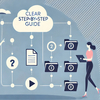
When you are starting a new documentation project, you might be looking for guidance. So, in this post, you will find a user manual template that works best for software documentation. The provided guidelines can be applied to other types of user manuals, as well. Without further ado, a software user manual template you can follow through to produce a high-quality technical document from scratch.
1. Introduction and General Info
This is where you provide readers with basic info about the product and also let them know what they can expect from this user manual. Here are some ideas of what can be added here:
- General info about the software product. A brief description of its main use cases and features. Adding a short and sweet overview video could work well for this part, too.
- What’s new. It’s great to let readers know that you are constantly working on your tool and get them familiar with the most significant and freshest improvements right off the bat.
- Version history. A useful reference point.
- System requirements. Before installing your software, people will need to make sure it is going to work on their computers. Try placing this section higher in the TOC.
- Installation and download information. The first thing people would need to do to get started is actually to install your app, or sign up for an account in case of cloud services.
- Migration options and supported formats. A part of your client base is coming from different software, and data migration is an important step for them.
- Upgrade process from earlier software versions. When we talk about software that needs to be installed, upgrading to a new version might become a challenge as users need to know how to do that correctly. User guides should make this process painless by providing clear upgrade instructions. In case of cloud services, vendors manage the upgrades and clients don’t have to think about this. Hence, for cloud services, you may not need the upgrade process description.

2. Getting Started Tutorials
User manuals can be a great adoption tool. So, make sure to include tutorials to your documentation. It can be organized as one long tutorial divided into logical parts. Try using as many visuals for this section as possible – new users need a visual reference since they are working with a completely new interface. What you might consider obvious can be totally unknown for them. Tutorials with text and images work great, but if you have the resources, consider adding training videos to provide additional training options.
3. Main Section
The main section is going to contain a lot of help topics. This is your bread and butter. It should describe all major features of the tool in question. Approach creation of this section with due care – you can’t pile it up with help topics, you need to build a solid backbone structure first. So, you should sort product features and unite them into bigger groups. Don’t go too crazy about it though – when the TOC hierarchy gets too deep (deeper than 4 levels), it becomes very confusing to navigate. Check out some tips on how to organize your TOC. Here’s how a feature help topic can look:
- Topic title. It should be concise and contain no ambiguities.
- Navigation elements. Breadcrumbs work best for the top. If the help topic is lengthy, consider adding a mini-TOC with quick links to the topic sections.
- Topic body.
- General feature description. Here, you simply state what this feature does.
- In-depth analysis of the feature. In this part, you provide a detailed description.
- Videos demonstrating how to use it.
- Examples of usage.
- Navigation elements that will take the reader to topics relatable to this one (Next/Previous Topic links, a See Also list).
- Footer. Footers can contain a lot of helpful information like contact links, a link to your website, etc. Footers can include navigation elements, as well.
- Comments section. Not everyone likes the idea of having a comments section, but, actually, this is a good way to establish trust with your customers by enabling an additional feedback channel. Also, the comments will provide you with a lot of improvement ideas.
An FAQ section is a great case-deflection tool. It can’t replace a thoroughly-written help topic, but it can help you cover a lot of simple questions that come up in support tickets or on product demos. You can add it to the main section, or turn into a standalone parent node. If you would like to learn more about creating great FAQ sections, check out this post – How to Create FAQ and Knowledge Base in ClickHelp.

Conclusion
You won’t find two identical user manuals. If different teams of tech writers were to create documentation for the same product, it would be different. However, the guidelines listed above should help you develop a robust mock-up for the project you are working on that you can further develop into a great user manual.
Good luck with your technical writing!
ClickHelp Team
Author, host and deliver documentation across platforms and devices



